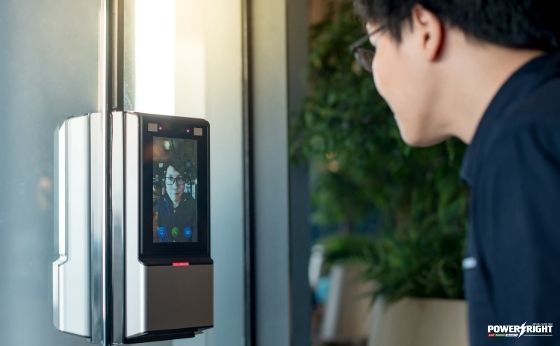
Biometrics has become part of our daily and work life: smart door entry systems with face recognition, customer service with voice authentication and mobile phones with touch ID, to name a few.
As biometrics access control systems become more accurate in confirming identities, a rising number of businesses are implementing this technology to grant employees access to devices, data and facilities.
What Are Biometrics?
Biometrics are biological (genetic and molecular traits) or morphological (facial structure, fingerprint or retina patterns etc.) measurements that we can use to identify a person and prove their identity.
What Are the Most Common Types of Biometric Identifiers?
The five most popular kinds of biometric systems use physiological characteristics, such as facial structure, iris, fingerprints, voice, and palm vein patterns.
How Does the Technology Work?
Most businesses use a biometric system as an effective access control solution to protect their premises and sensitive data. Employees enrol in the system by allowing a scanner to capture their biometric data. Images or measurements are stored as templates to be compared later against “live” information provided by the door entry system or face recognition terminal.
It is essential to weigh the advantages and disadvantages of biometric systems. You may choose to implement this technology in order to:
Enhance Security
Unlike passwords and key cards, biometric traits cannot be stolen or lost, which makes these systems more trustworthy than their conventional counterparts. Moreover, even though biometric access control systems are not completely foolproof, the chances of someone faking them are minimal.
Improve convenience
Employees do not have to waste time searching for a key card or even remember their password. On top of that, biometric systems identify and authenticate people much faster than non-biological alternative systems. Employers also benefit from this method as it supplies authentic attendance data facilitating the process of calculating late sign-ins, leaves and overtime for workers.
Reduce expenses
Employees lose keycards from time to time, and the costs to replace them can add up quickly. Additionally, it takes time to arrange replacements or reset passwords.
Although face recognition terminals or door entry systems are pricey to purchase, bear in mind that the cost of data breach recovery is usually much higher.
Certainly, there are a few disadvantages:
Physical Changes Can Influence the Accuracy
The data stored never change, but physical attributes sometimes do. The most insignificant changes in physical traits can lead to authentication failure. Thus, the system has to be altered, which is inconvenient.
Resetting Is Problematic
While a stolen password is fairly effortless to restore, new biometric data cannot be easily issued.
Biometric Systems Are Not Suitable for Every Application
A number of factors can impact whether a particular type of system will work for your company. For example, a fingerprint or any other contact type of door entry system might not be the best choice after the pandemic.
Initial High Costs
Such systems’ hardware, integration and setup require a considerable upfront investment. Small businesses may experience difficulties here even though cost savings is one of the possible advantages.
Given the various uses, benefits and drawbacks of biometric technology, small and midsize businesses have quite a few factors to consider prior to rolling out such solutions. The most advantageous options might be contactless terminals such as iris or face recognition systems allowing streamlined access processes and increased operational efficiency. Nonetheless, building a broader base of knowledge about this technology will assist in making an informed decision and increase the potential for return on investment.